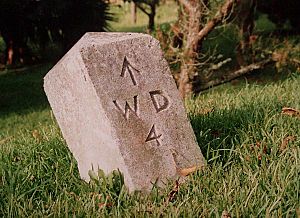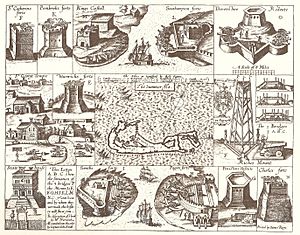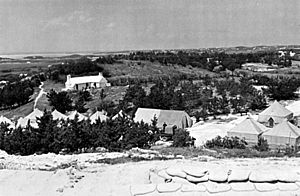Military of Bermuda facts for kids
Even though the United Kingdom is in charge of protecting Bermuda, the island still has its own defense force. This force helps keep Bermuda safe.
Contents
History of Bermuda's Defenses
Early Defenses: Protecting Bermuda
When the first governor, Richard Moore, arrived in Bermuda on July 11, 1612, his main worry was protecting the island from a possible Spanish attack. He and 51 other settlers joined three men already there from a shipwreck in 1609.
Building strong forts with coastal artillery (big cannons near the coast) was the most important job. Volunteers operated these cannons. Sometimes, even criminals were made to serve in the forts instead of going to prison.
A local army, called a militia, was also formed. It was like the militias in England. This militia grew to include nine companies, one for each parish (a local area). All healthy males aged 16 to 60 had to serve in the militia, whether they were free, working to pay off a debt, or enslaved.
Bermuda During the English Civil War
During the English Civil War (a big fight in England), Bermuda mostly supported the King. In 1649, Bermuda was the first of six colonies to say that Charles II was King after his father, Charles I, was executed.
Because of this, the English Parliament tried to stop trade with Bermuda and other colonies in 1650. Bermuda's Royalists (supporters of the King) took control of the militia and removed the governor. They chose John Trimingham as the new leader. Many people who supported Parliament were sent away to settle the Bahamas.
In 1651, Parliament sent a navy force to capture Bermuda. But Bermuda's defenses, including its forts, cannons, and militia, were too strong. The navy had to blockade Bermuda for several months. Eventually, the Bermudians negotiated a peace agreement.
Bermuda's Role After American Independence
After the American War of Independence, Britain lost many ports in its former colonies. This made Bermuda very important for the Royal Navy (Britain's navy). Bermuda became the main Royal Navy base in the Western Atlantic.
To protect this important naval base, more military defenses were built. The local militia was thought to be no longer needed because there were so many regular soldiers. So, the colonial government let the militia stop operating after the War of 1812. However, volunteer units were formed later to help the military garrison (a group of soldiers stationed in a place).

In 1815, Hamilton became the capital city. This happened partly because the Royal Navy spent 12 years mapping Bermuda's reefs. They found a deep channel that ships could use to reach the Great Sound, where they wanted to build a naval base. This channel also led to Hamilton Harbour.
Bermuda became one of Britain's four "Imperial fortresses." It was a naval base and a place for ships to refuel with coal. It was also the only dockyard between Canada and the West Indies where large ships could be repaired. During the War of 1812, the blockade of the southern US coast and the Burning of Washington were planned from Bermuda.
Changes in Military Presence
Before the American War of Independence, only a small British Army unit was in Bermuda. As the Royal Navy grew in the early 1800s, many new forts and batteries were built. More British Army soldiers, including infantry and artillery, were sent to Bermuda.
However, the cost of all this military building was too high. Also, there were not enough artillery soldiers to operate all the cannons. New technology quickly made many forts old-fashioned even before they were finished. Some were abandoned soon after being built.
After the Crimean War, Britain started to reduce its military forces in colonies like Bermuda. This was partly to save money. Also, it was realized that the Royal Navy's own ships could better defend the Dockyard and Bermuda. Still, because Bermuda was so important strategically, the withdrawal of troops happened very slowly. It continued until after World War I. The last regular army units left when the Dockyard closed in the 1950s.
In the 1860s, the building of naval and military structures brought much-needed money to Bermuda. At this time, Bermuda's traditional industries, like shipbuilding, were struggling because of new steel ships and steam engines. The American Civil War also briefly boosted Bermuda's economy. Later, tourism and farming grew, but military defense remained central to the economy into the 1900s.
Bermuda's importance as a naval station was clear during both World Wars. Its location in the North Atlantic, its protected waters, and the Royal Naval Dockyard were key. Since the US became an ally in both wars, US forces also started using Bermuda.
World Wars and US Bases
During World War I, the US Navy had a station in Bermuda. It helped anti-submarine vessels crossing to Europe. US Navy ships also used the island, which was a hub for trans-Atlantic convoys.
This cooperation grew in World War II. Before the US joined the war, Britain gave the US a free 99-year lease for a base in Bermuda. This was part of a larger agreement, but no ships were traded for this base. The agreement said that the airfield built in Bermuda would be shared with the Royal Air Force.
In 1941, the US Army and US Navy began building air stations (an airfield and a flying boat station). They also built coastal artillery batteries. The US operated these bases until the end of the Cold War. The bases covered about 5.8 square kilometers (2.25 square miles) of land, much of it created by filling in parts of the sea. From 1941 to 1945, the Bermuda Base Command managed the US Army's air, anti-aircraft, and coastal artillery forces in Bermuda.
The US bases were not the only air stations in Bermuda. The civilian airport, a flying boat station on Darrell's Island, was taken over by the RAF at the start of the war. The airline that operated there continued its trans-Atlantic service throughout the war, using camouflaged flying boats. US Navy aircraft also briefly flew anti-submarine patrols from Darrell's Island before their own base was ready. Before the US joined the war, the Royal Navy's own flying boats also flew anti-submarine patrols from their base on Boaz Island.

After World War II, the value of the British bases in Bermuda decreased. Britain was nearly bankrupt from the war and was rethinking its global military role. However, the air bases stayed open long after the war. From 1954 to 1995, the US Navy also operated a submarine-detecting station called Naval Facility Bermuda at Tudor Hill.
The Royal Naval dockyard and the military garrison closed in the 1950s. A small supply base, HMS Malabar, stayed open in the Dockyard until it closed in 1995, along with the American and Canadian bases. The US bases closed on September 1, 1995. However, issues like environmental cleanup delayed the land being returned to Bermuda until 2002.
Today, the only military unit left in Bermuda is the Royal Bermuda Regiment. This unit combines the volunteer groups formed in the 1800s with army and naval cadet corps.
Bermuda's Defense Forces Today
- The Royal Bermuda Regiment
- Bermuda Police Service
- Bermuda Reserve Police
- Airport Security Police
- Bermuda Cadet Corps
- Bermuda Sea Cadet Corps
Past Defense Groups
- Bermuda Militia Artillery
- Bermuda Volunteer Rifle Corps
- Bermuda Volunteer Engineers
- Bermuda Militia Infantry
- Bermuda Home Guard
The defense of Bermuda is the responsibility of the United Kingdom.
Historical Military Locations in Bermuda
- Bermudian Privateering (private ships allowed to attack enemy ships)
- Royal Naval Dockyard Bermuda, and the Royal Navy in Bermuda (1795–1995)
- Royal Naval Air Station Bermuda (1939–1943)
- Corps of Colonial Marines (1814–1816)
- Castle Islands Fortifications
- British Army, Bermuda Garrison (1701–1957)
- Bermuda Militia (1612–1815)
- St. George's Garrison
- Prospect Camp
- Warwick Camp
- Boaz Island and Watford Island (British Army base)
- Ordnance Island
- Agar's Island
- Locally raised Militia, Volunteer and Territorial Army Units (1894–1965)
- Royal Air Force, RAF Darrell's Island (1939–1945)
- Royal Air Force, Kindley Field (1943–1945)
- Royal Canadian Navy, HMCS Somers Isles (1944–1945)
- Royal Canadian Navy, Naval Radio Station Bermuda, Daniel's Head (1961–1968)
- Canadian Forces, Canadian Forces Station Bermuda, Daniel's Head (1968–1993)
Former US Bases In Bermuda
- United States Naval Station, Base 24, on White's Island, Bermuda (First World War)
- United States Naval Supply Station, Bermuda at Agar's Island (First World War)
- US Naval Operating Base, Naval Air Station Bermuda, and Naval Air Station Bermuda Annex (Southampton Parish) (1941–1995)
- United States Navy Submarine Base, Ordnance Island (Second World War)
- United States Navy, Naval Facility Bermuda (Tudor Hill) (1954–1995)
- Bermuda Base Command, US Army (1941–1945)
- United States Army, Fort Bell (1941–1948)
- United States Army Air Forces, Kindley Field (1943–1948)
- United States Air Force, Kindley Air Force Base (1948–1970)
- United States Naval Air Station Bermuda (St. George's Parish) (originally Kindley Field) (1970–1995)
- United States Coast Guard Air-Sea Rescue, at Naval Station Bermuda and Kindley AFB
- National Air and Space Administration, at Kindley AFB/US NAS Bermuda
See also
- Imperial fortress
- Bermudians in the Canadian Expeditionary Force
- Bermudians Against the Draft




